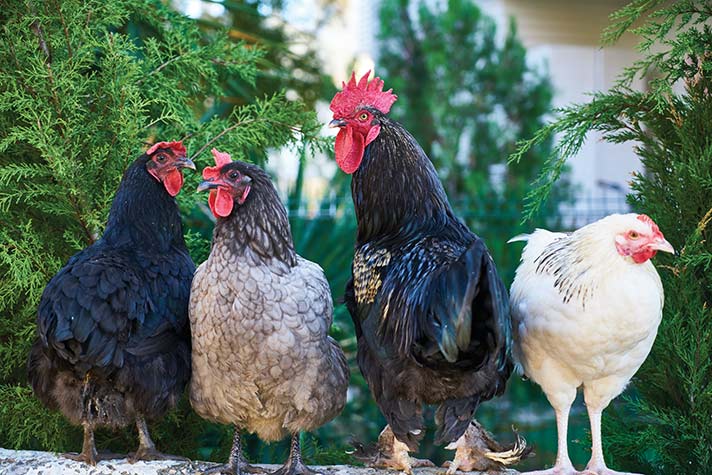On Real Estate & More – August 2021
Raising chickens in urban areas has become a popular pastime for many families. Some people want to produce eggs or meat to save money, live more sustainably, or simply know where their food comes from; others like to keep “fancy” or special breeds of chickens. Some people have chickens to eat insects in the lawn and garden; others simply like watching the birds in their yard, which sometimes can be a comical sight.
In recent years, issues regarding sustainability and animal welfare, organic food and local food production have increased people’s interest in raising chickens in urban environments. Because of their small size, chickens are ideal for urban environments, especially when compared to other livestock species such as sheep, goats, pigs, and cattle. Most cities have restrictions that ban livestock, but chickens are usually allowed as long as regulations (such as numbers of chickens, property line setbacks, and the absence of roosters) are followed.
As the owner of chickens in an urban setting, you must consider carefully:
- Location of animal facilities in relation to residences
- Location of feed storage to avoid rodent problems
- Fly control
- Sanitation management
- Safe disposal of animal waste
You must also take into account the health of your animals. The chickens must be given adequate space, good nutrition, and an enclosure (coop) to provide protection from the elements and predators.
In the City of Jacksonville, non-Commercial keeping of chickens is permitted within city limits (but is not permitted on properties zoned General Commercial).
- The chickens must be kept on the owner’s property, and any compound, pen, run, shed, or fenced area of confinement may not be located closer than 10 feet to any property line and 30 feet to a dwelling on any contiguous property.
- Chicken Coops must be set back at least 30 feet from all neighboring structures. Coops must be under eight feet in height and under 200 sq. ft. Coops must be setback at least 10 feet from all property lines and at least 30 feet from all neighboring structures. Coops must be located in a side or rear yard only—not the front yard. Prior to the construction or installation of a chicken coop, contact the Planning Department to verify that no further action needs to be taken.
- Provide a minimum of 1 square foot of floor space (for permanent indoor confinement areas) per pound of body weight. Most hens weigh from 4 to 6 pounds (bantams are smaller), so each hen needs 4-6 square feet of ground space. In addition, when chickens are kept in enclosed spaces, they need adequate air space to ensure safe air quality and minimize odors. In Oregon, cold temperatures are not usually a problem for chickens. However, heat lamps or other heat sources may be needed if winter temperatures dip into the single digits.
- Allow chickens to roam in the backyard for at least part of the day. These free-range chickens will eat large amounts of insects, grasses, and seeds. They will also eat ornamental and vegetable plant gardens in their search for insects. Chickens will scratch-up the garden and lawns.
- Provide a prepared diet. Even though chickens enjoy insects and seeds found in the yard, and most kitchen waste, hens also need a prepared diet to thrive and lay eggs. This prepared diet must be formulated to contain all the required nutrients. To discourage rodents, store feed in a container and immediately clean up any spills.
- Clean enclosed animal facilities and any ranging areas on a regular basis. Dispose of manure and litter promptly and properly. Used litter and manure are especially good for garden composting because of their high nitrogen content.
Keeping chickens in your yard has many benefits, from supplying you with fresh, healthy eggs from well-cared-for animals, to giving you great fertilizer for gardening, to providing lively pets—as well as being part of the drive to local, sustainable food systems.

 Sandy J. Brown lives in Jacksonville and is a real estate broker and land use planner with Windermere Van Vleet Jacksonville. She can be reached at sandyjbrown@windermere.com or 831-588-8204.
Sandy J. Brown lives in Jacksonville and is a real estate broker and land use planner with Windermere Van Vleet Jacksonville. She can be reached at sandyjbrown@windermere.com or 831-588-8204.